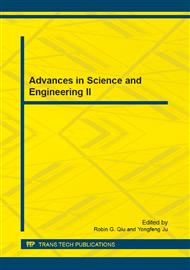[1]
ZHANG Hua-ping , LIU Qun, CHENG Xue-qi, et al. Chinese lexical analysis using hierarchical hidden Markov model[C]/Proceedings of the 2nd SIGHAN Workshop on Chinese Language Processing. Morristown, NJ: Association for Computational Linguistics, 2003: 63-70.
DOI: 10.3115/1119250.1119259
Google Scholar
[2]
A. Panuccio ,M. Bicego ,V. Murino . A Hidden Markov Model-based approach to sequential data clustering. In: Structural, Syntactic and Statistical Pattern Recognition (SSPR02) , Springer , 2002 , 734-742.
DOI: 10.1007/3-540-70659-3_77
Google Scholar
[3]
Yuan Lei. based on probabilistic model for text clustering [D] Jilin University, 2005, 1-4.
Google Scholar
[4]
section Jiao Jiang, Xue Yongsheng, woods rain, Wang Wei, Shi Bole. A new Markov model based on hierarchical clustering algorithm for time series [J] Computer Research and Development, 2006, (01), 3 - 4.
Google Scholar
[5]
Bandyopadhyay S, Mauli k U. A n evolutionary technique based on K-Means algorithm for optional clustering in RN[J]. Information S ciences, 2002, 146: 221-237.
DOI: 10.1016/s0020-0255(02)00208-6
Google Scholar
[1]
Bennett C H, Brassard G. Quantum Cryptography: Public Key Distribution and Coin Tossing[C]. Proceedings of IEEE International Conference on Computers, Systems and Signal Processing. Bangalore, India: [s. n. ], 1984: 175-179.
Google Scholar
[2]
Deng F G, Long G L. Secure direct communication with a quantum one-time pad. Phys Rev A, 2004, 69: 052319.
Google Scholar
[3]
Cai Q Y, Li B W. Deterministic secure communication without using entanglement. Chin Phys Lett, 2004, 21: 601-603.
Google Scholar
[4]
K. Bostrom, T. Felbinger. Deterministic Secure Direct Communication Using Entanglement[J]. Phys Rev Lett, 2002, 89: 187902.
DOI: 10.1103/physrevlett.89.187902
Google Scholar
[5]
K. Bostrom, T. Felbinger. Deterministic Secure Direct Communication Using Entanglement[J]. Phys Rev Lett, 2002, 89: 187902.
DOI: 10.1103/physrevlett.89.187902
Google Scholar
[6]
Cai Q Y, Li B W. Improving the capacity of the Bostrom-Felbinger protocol [J]. Phys Rev A, 2004, 69: 054301.
Google Scholar
[7]
Kim Bostrŏm, et al. Deterministic secure direct communication using entanglement[J]. Phys. Rev. Lett, 2002, 89: 187902.
Google Scholar
[8]
Cabello. Quantum key distribution without alternative measurements. Phy. Rev. A. (2000).
Google Scholar
[9]
Yan FL, Gao T. Quantum secret sharing between multiparty and multiparty without entanglement[J]. Phys. Rev. A, 72 (2005), 012304.
DOI: 10.1103/physreva.72.012304
Google Scholar
[10]
Yu Y F, Xu Y, Liu J. A quantum secret sharing scheme among three parties ultilizing four-qubit Smolin bound entangled state[J]. arXiv: quant/ph/0605225v2 28 Sep (2006).
Google Scholar
[11]
Nguyen B A. Quantum dialogue. Phys Lett A, 2004, 328: 6-10.
Google Scholar
[12]
Gao F, Guo F Z, Wen Q Y et al. Revisiting the security of quantum dialogue and bidirectional quantum secure direct communication. Sci China Ser G-Phys Mech Astron, 2008, 51(5): 559-566.
DOI: 10.1007/s11433-008-0065-y
Google Scholar
[13]
Tan Y G, Cai Q Y. Classical correlation in quantum dialogue. ArXiv: 0802. 0358.
Google Scholar
[14]
Shi G F, Xi X Q, Tian X L, et al. Bidirectional quantum secure communication based on a shared private Bell state. Opt Commun, 2009, 282: 2460-2463.
DOI: 10.1016/j.optcom.2009.02.062
Google Scholar
[15]
Gao F, Qin S J, Wen Q Y, et al. Comment on: Three-party quantum secure direct communication based on GHZ states, [Phys. Lett. A 354 (2006) 67]. Phys Lett A, 2008, 372: 3333-3336.
DOI: 10.1016/j.physleta.2008.01.043
Google Scholar
[16]
Man Z X, Xia Y J. Improvement of Security of Three-Party Quantum Secure Direct Communication Based on GHZ States. Chin Phys Lett, 2007, 24: 15-18.
DOI: 10.1088/0256-307x/24/1/005
Google Scholar


